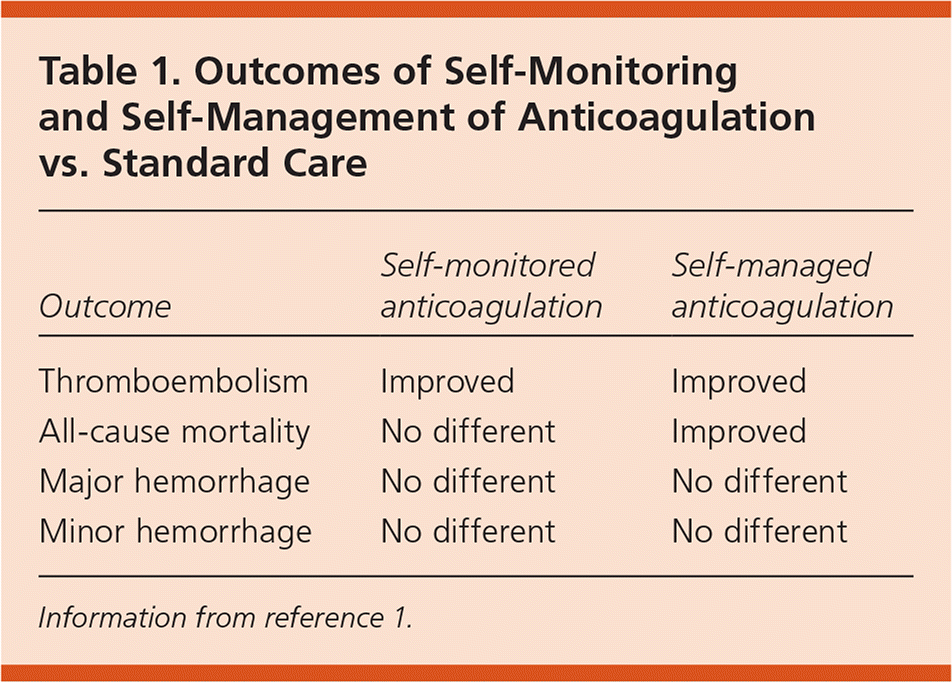
Am Fam Physician. 2017;95(11):700-701
Author disclosure: No relevant financial affiliations.
Clinical Question
Does self-monitoring or self-management improve the safety, effectiveness, and feasibility of long-term oral anticoagulation therapy compared with traditional monitoring?
Evidence-Based Answer
In patients taking warfarin (Coumadin) for anticoagulation, there is moderate-quality evidence that both self-monitoring (number needed to treat [NNT] = 100) and self-management (NNT = 53) reduce thromboembolic events, and that self-management reduces all-cause mortality (NNT = 67). There is low- to moderate-quality evidence that neither self-management nor self-monitoring reduces major or minor hemorrhage. Physicians should consider self-management or self-monitoring for patients who are willing and able to use these strategies.1 (Strength of Recommendation: A, based on consistent, good-quality patient-oriented evidence.)
Practice Pointers
Portable point-of-care (POC) devices for monitoring long-term oral anticoagulation have been available since the 1990s. Self-monitoring is a strategy in which the patient can measure his or her international normalized ratio (INR) with a POC device, then adjust warfarin dosing by calling a clinic for advice. Self-management strategies refer to patient use of a POC device to measure the INR and adjust warfarin dosage according to a predetermined schedule on physician-approved algorithms. Advantages of both strategies may include patient convenience, ease of monitoring, and fewer thromboembolic complications. A 2006 study suggested that self-monitoring and self-management are cost-effective strategies for those receiving long-term oral anticoagulation.2
A previous version of this review found that use of POC devices by patients for self-monitoring or self-management of anticoagulation improved all-cause mortality, rates of venous thromboembolism, and rates of minor hemorrhage. Self-monitoring also improved rates of major hemorrhage.3
In updating this Cochrane review, the authors found 10 new trials with 4,227 additional patients to bring the aggregate to 28 randomized controlled trials including 8,950 participants.1 The authors assessed risk of bias as low to moderate because blinding participants to allocation was not possible. Studies lasted from three months to nearly five years.
Using this larger body of literature, the authors found that when compared with standard care, self-monitoring of anticoagulation reduced thromboembolic events (absolute risk reduction [ARR] = 1%; 95% confidence interval [CI], 0.1% to 1.8%; NNT = 100 [95% CI, 56 to 1,000]), whereas self-management of anticoagulation reduced thromboembolic events (ARR = 1.9%; 95% CI, 1.1% to 2.4%; NNT = 53 [95% CI, 42 to 91]) and all-cause mortality (ARR = 1.5%; 95% CI, 0.5% to 2.1%; NNT = 67 [95% CI, 48 to 200]). The authors also found a greater reduction in thromboembolic events for patients with atrial fibrillation compared with those who had mechanical heart valves and self-monitored or self-managed anticoagulation therapy. The larger evidence base (with the inclusion of the additional studies) no longer shows that self-monitoring reduces all-cause mortality. There is also no evidence that either approach is associated with lower or higher rates of minor or major hemorrhage (Table 1).1
Self-monitoring or self-management may not be feasible for up to one-half of patients needing anticoagulation; barriers encountered by study participants included physical limitations, ability to properly use a monitor, ability to participate in training, and ability to successfully complete training. Furthermore, the evidence to date is insufficient to provide valid comparative information between POC monitors regarding ease of use, accuracy, and patient costs (after insurance coverage).4

| Outcome | Self-monitored anticoagulation | Self-managed anticoagulation |
|---|---|---|
| Thromboembolism | Improved | Improved |
| All-cause mortality | No different | Improved |
| Major hemorrhage | No different | No different |
| Minor hemorrhage | No different | No different |
The findings of this updated review are consistent with previous evidence, as well as a 2012 meta-analysis of individual patient data from 11 studies that found a significant reduction in thromboembolic events in the self-monitoring group, especially among younger patients and those with mechanical heart valves.5 A 2015 health technology assessment also had similar overall findings, and noted that costs of self-monitoring and self-management over 10 years were similar to costs of standard monitoring.4
For venous thromboembolism, current guidelines recommend warfarin or a direct anticoagulant (e.g., apixaban [Eliquis], dabigatran [Pradaxa], rivaroxaban [Xarelto]).6 For many patients with atrial fibrillation, guidelines now recommend using a direct anticoagulant; however, for those with stage IV chronic kidney disease, a mechanical prosthetic valve, or rheumatic mitral stenosis, warfarin is still preferred.7 Current guidelines from the U.K.'s National Institute for Health and Care Excellence (NICE) recommend using POC monitors for self-monitoring of anticoagulation by patients with atrial fibrillation or heart valve disease who can be suitably trained,8 but NICE does not recommend self-monitoring or self-management for patients with venous thromboembolism.9
The practice recommendations in this activity are available at http://www.cochrane.org/CD003839.
editor's note: The numbers needed to treat reported in this Cochrane for Clinicians were calculated by the author based on raw data provided in the original Cochrane review.
